Abstract
In response to the limitations of the existing online learning system regarding the efficiency and accuracy of the question-and-answer (Q&A) teacher recommendation method, this research develops a Q&A teacher recommendation model utilizing a Graph Convolutional Neural Network. First, a time-sensitive online learning Q&A teacher recommendation model (A Time Sensitive Online Learning Q&A Teacher Recommendation Model; TSRM) is proposed to address the shortcomings that current recommendation methods ignore, i.e., the teacher’s ability to answer questions with time changes. Then, a TSRM based on Short and Long Term Interest for Answering Questions (LSTR) is proposed to address the problem that the current recommendation methods ignore, i.e., the types of questions of student users’ concerns can change. Finally, we combine the TSRM model and LSTR model to build an intelligent recommendation model for answering teachers. The conclusion is that the accuracy rate of TSRM model on the test set is 99.5%, and the recommendation success rate of LSTR model reaches 98.4%, which are better than the other two models. The above results can show that the LSTR model and TSRM model constructed by the study have high performance and can effectively perform the recommendation of answering teachers in the online learning system, thus improving the efficiency of solving students’ problem, improving students’ learning effect, and contributing to the development of university education informatization.
1 Introduction
With the rapid development of Internet technology, the traditional education model is gradually changing to the online learning system, and in this process, the intelligent recommendation of answering teachers has become the key link to improve the learning efficiency [1]. Effective teacher matching can not only enhance the learning experience, but also promote the rational distribution and utilization of educational resources [2]. Unfortunately, the current online learning platform still has many shortcomings in answering teacher recommendations, such as low accuracy and insufficient personalization, which limits the development potential of online education model [3]. In order to solve this problem, the aim of this study is to construct an intelligent recommendation model for question answering teachers based on graph convolutional neural network (GCNN). By mining the multi-dimensional interaction data between teachers and students, the model captures the individual needs of learners and makes intelligent matching based on it. GCNNs provide an ideal tool for capturing complex teacher–student interaction patterns due to their strong representation ability on graph data [4]. GCNN is an emerging deep learning technique that extends the convolutional operations in traditional CNN to graph data, and is widely used in fields such as intelligent recommendation and traffic prediction [5,6]. The innovation of this study is that it integrates the advantages of GCNN in node classification and link prediction, and recommends the most suitable teacher for each learner. Through deep learning of node features and efficient encoding of edge relationships, the model can gain insight into the real needs of learners and the professional competence of teachers, so as to achieve high-precision personalized recommendation. The study offers a novel viewpoint and methodological approach for enhancing intelligent recommendation within online learning ecosystems, aiming to refine the precision of recommendations as well as to augment the level of personalization. The deployment of this model is anticipated to substantially elevate instructional quality and augment efficiency in the online learning milieu, thereby fostering innovation and progression in the domain of online education. Section 2 is a review of the research results related to GCNN and intelligent recommendation, Section 3 is the construction of two intelligent recommendation models based on GCNN, Section 4 is the performance analysis of the intelligent recommendation models for answering teachers, and Section 5 is the summary of the whole research.
2 Related works
GCNN is a new technique built on CNN, which can extend the convolutional operation in traditional CNN to graph data, and has wide applications in citation networks, intelligent recommendation, intelligent traffic prediction, and computer vision [7]. Yu et al. designed a GCNN-based ResGNet-C neural network and applied it to the detection of neocrown pneumonia, thus improving the efficiency and accuracy of neocrown pneumonia detection [8]. Yu et al. used GCNN to extract features and achieve intelligent prediction of road traffic speed considering the existence of regional spatio-temporal correlation of traffic roads, contributing to the construction of intelligent transportation [9]. Chen et al. designed a CNN model based on graph convolutional features and used the model to make intelligent prediction of stocks so as to provide data support for investors’ investment decisions [10]. Louis et al. proposed a GCNN with an improved structure and constructed a machine learning model for material performance prediction based on this improved GCNN. The experiment showed that the model owns high accuracy [11]. Wang and Chen, aiming at the trend of intelligent traffic system, proposed a real-time video object detection structure with high compression rate based on GCNN, and predicted the future traffic safety trend according to the previous traffic flow. The experimental results on real traffic datasets prove the excellent performance of this method [12]. Mou et al. designed a nonlocal GCNN and applied it to the field of hyperspectral image classification. Experiments showed that the model has high classification accuracy and classification efficiency in the field of hyperspectral image classification [13]. Min et al. proposed a strategy to improve the GCNN in order to avoid the over-smoothness property in the GCNN that affects the performance of the model, thus designing a scattering GCNN. This proved that the model can effectively overcome the over-smoothness in the traditional GCNN [14]. Spinelli et al. proposed a GCNN model based on adversarial training and applied the model to missing data interpolation so as to improve the integrity and quality of the data, which verified that the model can effectively perform missing data interpolation [15].
At present, with the overall spurt of information resources, information overload has become a problem of the times, and it has become a challenge to dig out effective resources from the massive information center and how to improve the utilization of information. In this context, recommendation systems can effectively alleviate the problem of information overload and allow two-way selection between information and users, and even tap into the potential needs of users and the potential value of information [16]. Zaidan and Zaidan analyzed and reviewed the literature related to IoT-based smart home applications and explored the application path and effect of AI-based smart recommendation technology in it [17]. Milano et al. conducted an application of current recommendation systems, in-depth exploration, and analysis, and expressed their views and discussions on their ethicality, which provided theoretical support for the research on the application development of recommendation systems [18]. Tahmasebi et al. designed a deep automatic coding network based on Twitter data and used the network to build a social movie recommendation system, so as to achieve personalized and intelligent social movie recommendations [19]. Wahab et al. proposed a trust-based joint learning method for the cold start problem in intelligent recommendation, so as to improve the recommendation accuracy of the recommendation system. The method showed that it has good results and can improve the performance of the recommender system [20]. Paleti et al. proposed an alternating least squares decomposition method based on community detection, thus solving the cold start problem in recommender systems and improving the recommendation efficiency and accuracy [21]. Brandão et al. designed a wavelet-based recommender system for cancer patients with intelligent drug recommendation to reduce patients’ pain and prolong their survival [22]. Chen et al. designed an autoclave process formulation parameter recommendation system and conducted an empirical study to verify the effectiveness of the system for parameter recommendation. The use of the system was effective in improving the autoclave process and enhancing the production efficiency [23]. Jelodar et al. proposed an LP algorithm that integrates Latent Dirichlet Allocation (LDA) and PageRank algorithm to improve the recommendation system in the educational question-and-answer (Q&A) platform. Experimental results have proved the effectiveness and excellence of this method [24]. Lyu et al. proposed a Weighted Hypertext Induced Topic Search (WHITS) recommendation algorithm based on link analysis, aiming to identify and recommend high-quality Q&A content and authoritative experts on online education platforms, and realize accurate and effective recommendation by analyzing the interactive relationship between students and answer content, as well as professional mutual recognition among teachers [25].
As described above, GCNNs are widely used and the research results related to intelligent recommendation play an important role in various fields. However, there are still more problems in the current research results of intelligent recommendation, which affect the recommendation effect, and there are few studies related to the recommendation of answering teachers in online learning systems. To address these problems, the research is based on GCNN to obtain the feature vector of student users and then construct the intelligent recommendation model of answering teachers. The research results can help the online learning system to achieve intelligent and efficient teacher recommendation, so as to solve students’ problems and improve their learning efficiency in a timely manner, which has certain guiding significance for the development of university education informatization.
3 GCNN-based teacher recommendation model construction for answering questions
3.1 Time-sensitive teacher recommendations based on Q&A
In the current online learning systems, Q&A teacher recommendations are generally based on the correlation between student and instructor users’ concerns and historical responses, or the sociality between student and instructor users. However, this approach ignores the problem that the teacher’s knowledge base and expertise grow dynamically over time [26]. Therefore, for a certain type of question, a certain teacher user cannot give an effective answer in the present, but in the future, that teacher user may be competent enough to answer that type of question. To address the above problem, the study proposes a time-sensitive online learning Q&A teacher recommendation model (A Time Sensitive Online Learning Q&A Teacher Recommendation Model, TSRM) based on the basic structure shown in Figure 1.
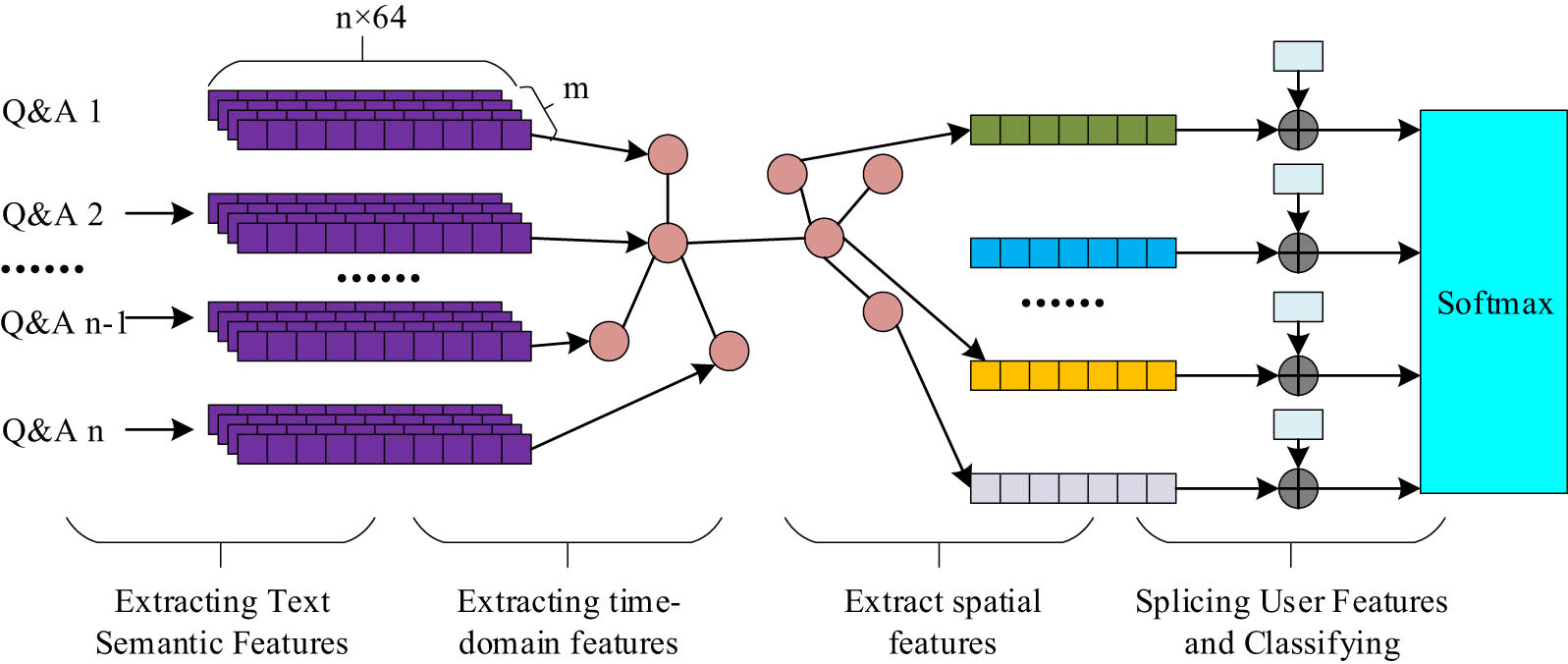
The basic structure of TSRM.
In the TSRM model shown in Figure 1, the number of likes of answers is taken as an important index to evaluate the quality of answers, and more likes indicate higher quality of answers and prove the higher level of Q&A teacher users. The relationship between users’ co-response and co-concern is analyzed, and a multi-relationship co-response network is constructed based on the analysis results, and a sequence of Q&A text is constructed by time series. The semantic features of the constructed text sequences are extracted by Bidirectional Encoder Representations from Transformers (BERT) model, the topology of the constructed answer network is learned to obtain the empty domain social features, and the time series on the quiz text The topology of the constructed response network is learned to obtain the spatial social features, and the change in the number of likes on the time series of Q&A texts is learned to obtain the time domain features. Finally, the extracted features are classified so that each node of the network can be predicted to determine whether teacher users are better at answering certain types of questions. Based on the GCNN idea, the undirected graph of the multi-relational co-answer network constructed in the study is noted as
where
The greater the similarity between the predicted and actual distributions of the model, the greater the objective function. The study introduces the relative entropy method to calculate the similarity between the predicted and actual distributions of the model. In the study, the question-answering teacher recommendation problem is viewed as a binary classification problem of graph nodes. Therefore, the goal of the TSRM model is to minimize the error between the predicted value
In the above, the time-domain features are generally obtained by the Long Short-Term Memory (LSTM) artificial neural network model, whose basic structure is shown in Figure 2.
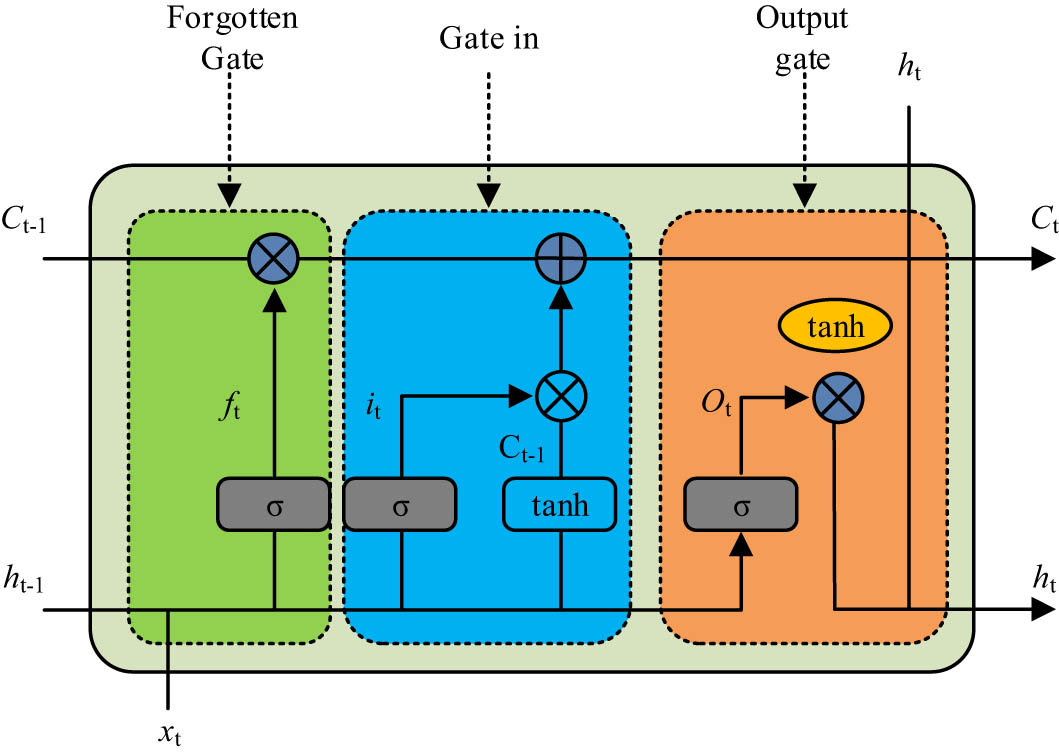
The basic structure of LSTM.
In Figure 2, we can see that the LSTM unit contains 3 internal gate structures: forgetting, input, and output gate. The LSTM is able to record long-term information through the gating mechanism, which has a good application in different scenarios. However, the structure of LSTM is relatively complex and the training time is long, so it is simplified to obtain Gated Recurrent Unit (GRU). Since GRU is simplified from LSTM, it has the advantages of LSTM while its structure is simpler and involves fewer parameters, so the training efficiency is higher. Based on the above reasons, the study uses GRU to obtain time-domain features. In this process, four main parts are involved, which are reset gate, update gate, and output gate. Based on LSTM, its calculation is specifically shown in formulas (4)–(8) [28]. Among them, the structure of the update gate can be expressed as equation (4), which is able to control the extent of the state information generated during the last training when it enters this training.
where
where
At the moment of
In equation (6),
Finally, GCNN is used to obtain the social features in the null domain. The specific process is as follows: first, the text features of user
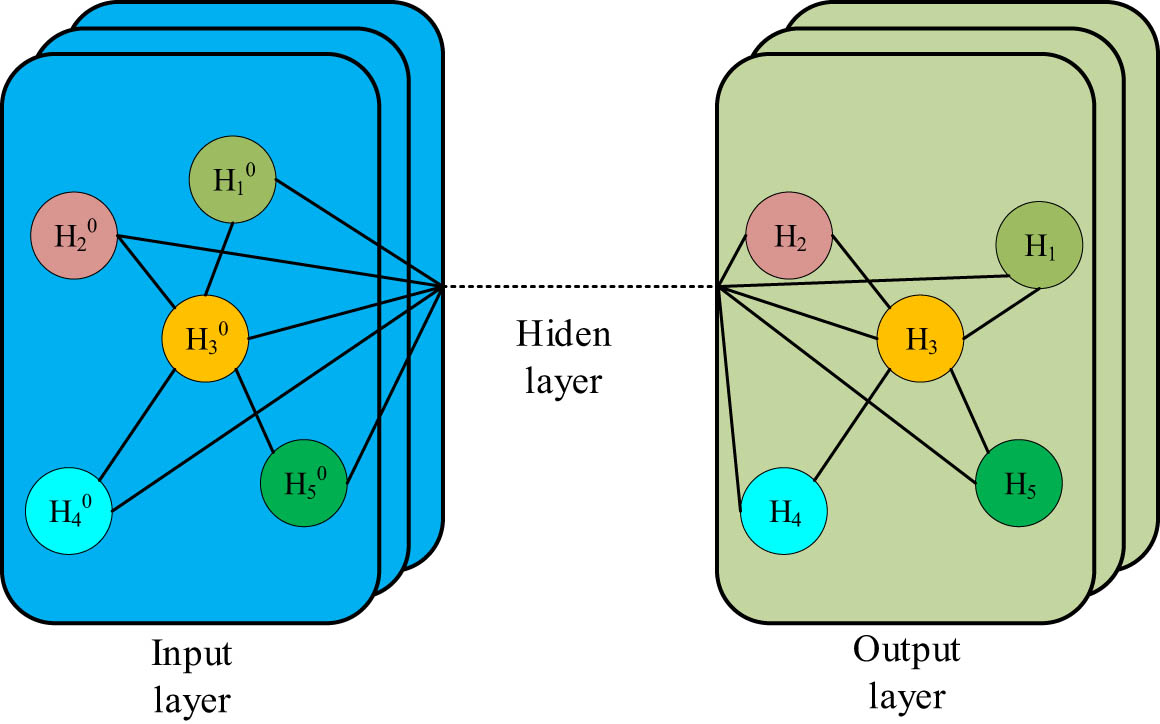
GCNN-based process for obtaining spatial social features.
The TSRM model is designed to provide students with the most suitable Q&A teacher. To do this, the model will take into account the multi-dimensional characteristics of students and teachers, and learn how to match teachers and students most effectively through intelligent algorithms. First, data about students and teachers need to be collected, and after the data are collected, it is pre-processed to clean, normalize, and encode it to ensure that the data are suitable for model processing. Then, natural language processing and machine learning techniques are used to extract feature vectors from students’ and teachers’ Q&A records and learning behavior logs. Next a graph structure is constructed, with nodes representing students and teachers and edges representing possible matching relationships between them, and a graph neural network is used to extract complex relationships and patterns between nodes. Finally, node features and graph structure are used to predict the matching score.
3.2 Teacher recommendation model based on long- and short-term interest in answering questions
In different periods of time, as time goes by, the learning content of student users will change, and therefore the types of problems that student users focus on will also shift to some extent. However, in current intelligent recommendation methods, this is often ignored, and the recommended teachers for answering questions are more fixed, which affects the efficiency of solving students’ problem [29]. And with the change in time, the user’s concern and good problem solving will also change somewhat, i.e., an interest shift occurs. If the user has a long time of interest shift, it is called long-term user shift; accordingly, if the user has a short time of interest shift, it is called short-term user shift. To remedy the shortcomings of traditional intelligent recommendation methods, a TSRM based on Short- and Long-Term Interest for Answering Questions (LSTR) is proposed. The model is divided into three parts: question vector feature extraction, user vector representation, and intelligent recommendation based on the extracted question vector features and user vector. In the problem vector feature extraction part, the study uses the BERT model to obtain the word embeddings of problem titles and labels. Based on BERT, the calculation process is shown in formulas (9)–(12) [30]. Let a question be
where
where
where
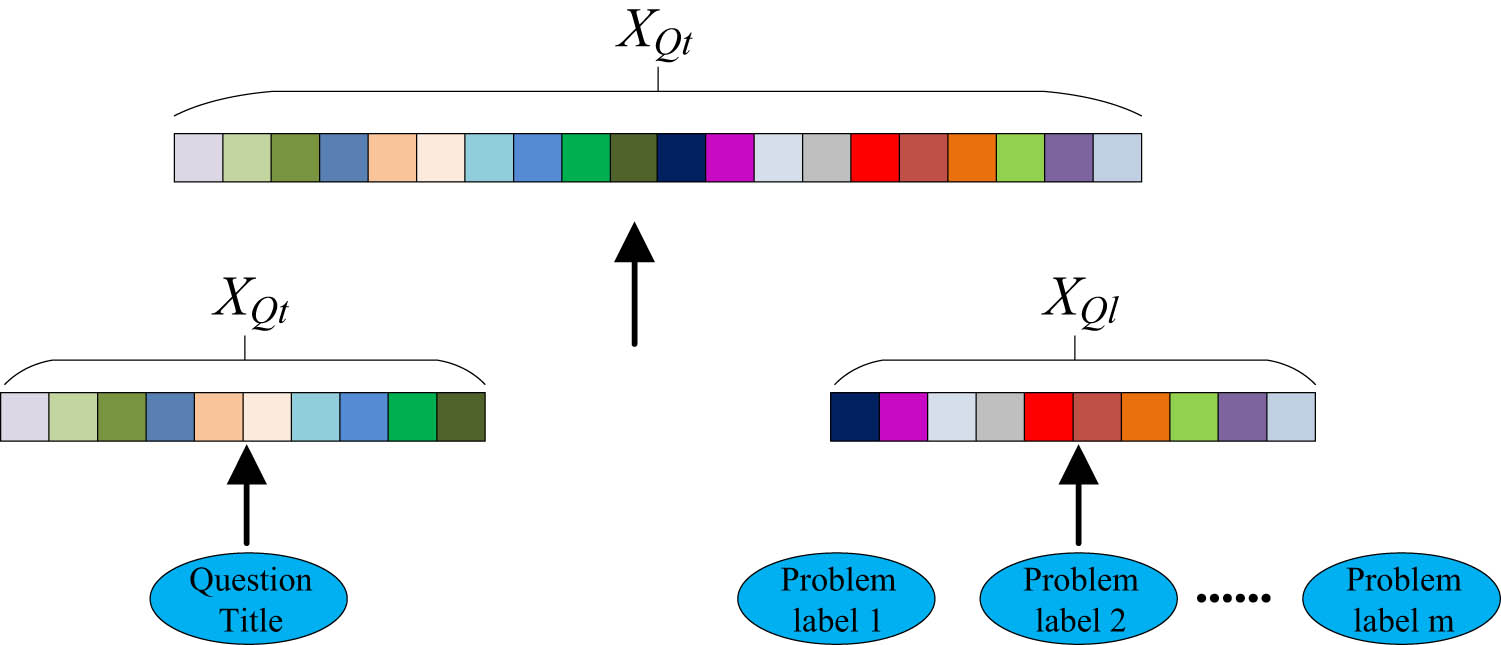
The process of obtaining vector representation of problems.
In addition, the social relationships of the users in the online learning system are analyzed. Users who have a relationship such as a common concern, a common answer, or a concern are considered to have a social relationship with each other. If a user is interested in a certain type of question, it is assumed that users with whom the user has a social relationship may also be interested in that type of question. Based on this theory, the list of questions that a user is interested in is considered as an attribute of the user, and each user is considered as a node, and the relationship between users in terms of concern or common answer is considered as an edge, thus building a multi-relationship common answer network with attributes. Based on GCNN, we extract the features of each node in the network, which can be regarded as the long-term interest of the user. Let the user’s concern question text be
Then, the GraphSage model is used to process and analyze the word embedding features to obtain the long-term interest features of users

User vector representation process.
Based on the obtained question vector and user vector, the answer teacher recommendation is implemented. The study uses a Deep Structured Semantic Model (DSSM) for result prediction. The extracted user feature vector
The above contents can be represented as Figure 6. The LSTR model is completed by combining the above contents. Combining the LSTR model with the TSRM model, efficient and high-precision teacher recommendation for answering questions can be achieved. Compared with the existing learning-based networks, the model uses graph structure to represent and process data, which is particularly suitable for processing graph structure data and can capture complex relationships and patterns between nodes. At the same time, it is able to process non-Euclidean structured data, such as social network data, namely, the relationship between students and teachers. This capability makes it suitable for recommendation systems, especially in situations where interactions between users need to be captured and exploited. And the model can solve the problem of teacher recommendation in online learning system, which is not covered by the traditional learning network.
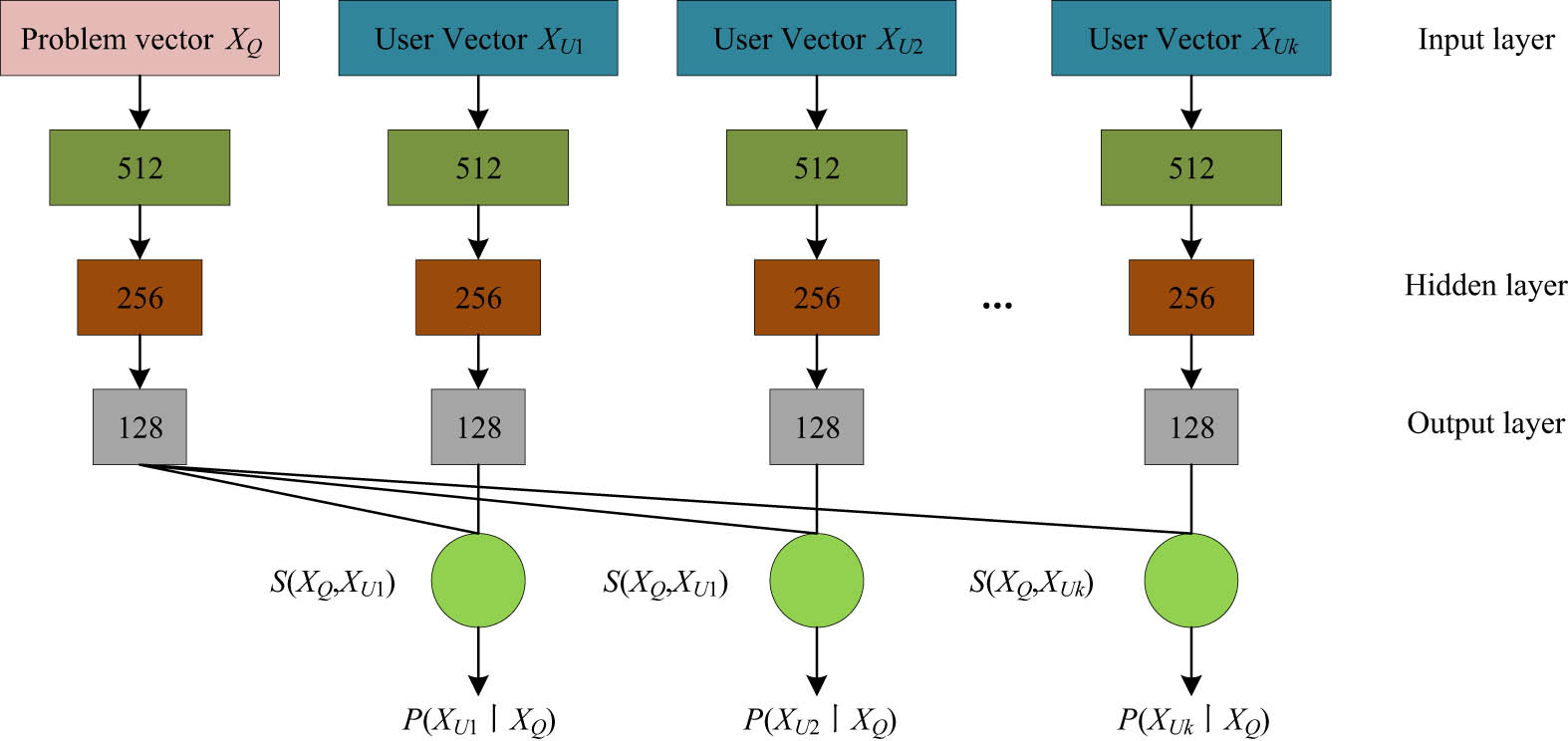
The basic structure of deep structured semantic model.
4 Performance analysis of LSTR model and TSRM model
4.1 Performance analysis of TSRM model
On the premise of obtaining consent, data were obtained from an online learning system of a university to construct a dataset, which included student dimension information, teacher dimension information, classroom content information, and interactive dimension information. Student dimension information includes students’ basic information, learning behavior, and historical question answering request. Teacher dimension information includes teachers’ basic information, historical evaluation, and historical Q&A information. The classroom content information includes the basic information of the course, the difficulty of the course, the students’ participation, and the degree of completion. Interactive dimension information includes historical question answering records between students and teachers. The dataset is divided into two subsets according to the ratio of 7:3, which are noted as the training set and the testing set, for the training and testing of the model. The detailed configuration parameters of hardware and software used in the study are shown in Table 1.
Details about software and hardware configuration parameters
| Hardware | Software | ||||
|---|---|---|---|---|---|
| Name | Supplier | Detail | Name | Supplier | Detail |
| GPU | NVIDIA | GeForce GTX 1660 Super | OS | Linux | Ubuntu 20.04 LTS |
| CPU | Intel | Core i5-10600K | Deep learning framework | CUDA | TensorFlow 2.6 |
| RAM | Kingston | 16GB-DDR4 | GCNN library | Deep Graph Library | 1.0 |
| MEM | SUMSUNG | 512GB-NVMe | Python environment | Anaconda | 3.8 |
Among the current online learning systems, there are two main state-of-the-art methods for teacher recommendation, which are LDA-PageRank model (LP) and WHITS model. First, the performance of TSRM model, LP model, and WHITS model is compared. First, the TSRM, LP, and WHITS model are trained using the training set, and Figure 7 shows the error variation and loss value variation of the three models during the training process. In Figure 7, we can see that the error and loss values of the three models decrease with the increase in the number of model iterations, and after the number of model iterations reaches a certain level, the error and loss values of the models stabilize and do not change significantly. Among them, the TSRM model needs 99 iterations to reach the optimal state, which is 48 and 103 times less than the LP model and WHITS model, respectively. In Figure 7(a), the error values of LP and WHITS are 0.02 and 0.03 higher than those of TSRM (0.02). In Figure 7(b), the loss values of TSRM (0.3) are 0.4 and 0.8 lower than those of LP and WHITS, respectively.
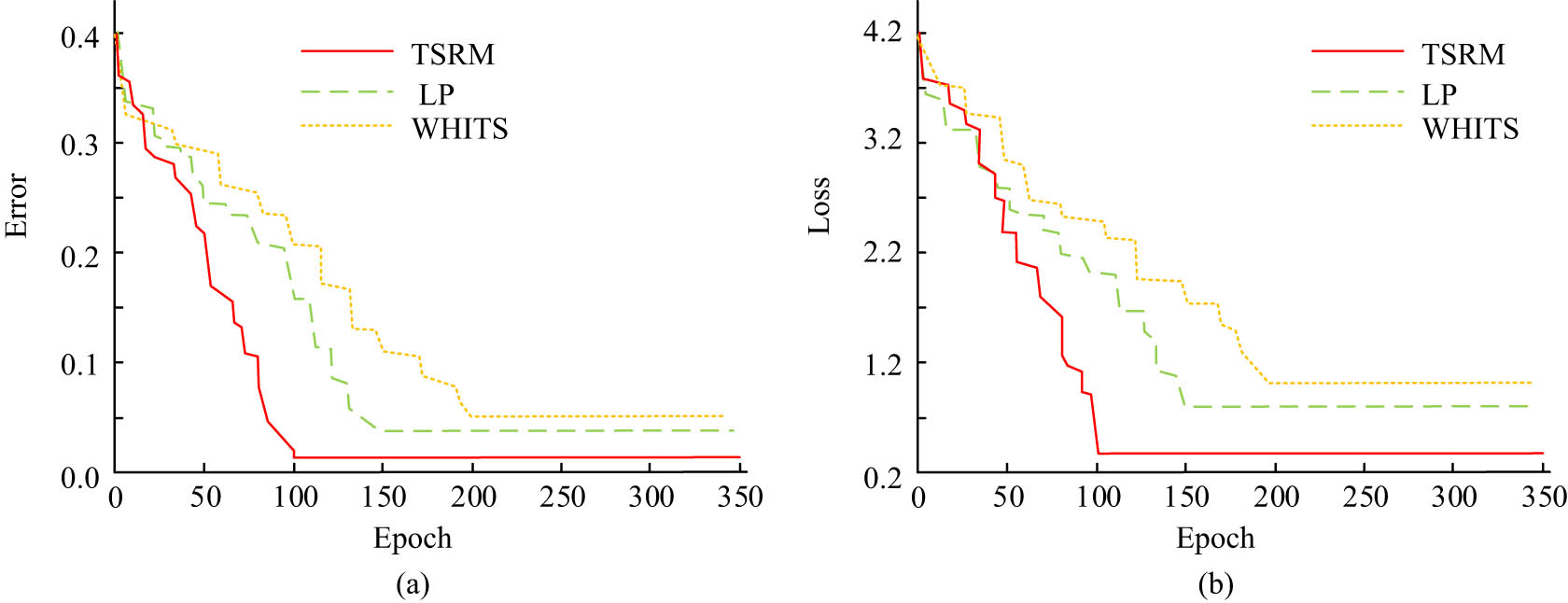
Error changes and loss value changes of three models during training. (a) Error. (b) Loss.
The performance of the TSRM model, LP model, and WHITS model was tested using the test set, and they are evaluated using F1 values and Recall values, as shown in Figure 8. In Figure 8, it can be seen that the F1 value and Recall value of the models increase as the number of iterations increases. In Figure 8(a), the TSRM’s F1 value is 96.5%, which is 1.1 and 1.4% higher than that of the LP and the WHITS. In Figure 8(b), the TSRM’s Recall value is 96.3%, which is 0.5 and 1.0% higher than the other two models.
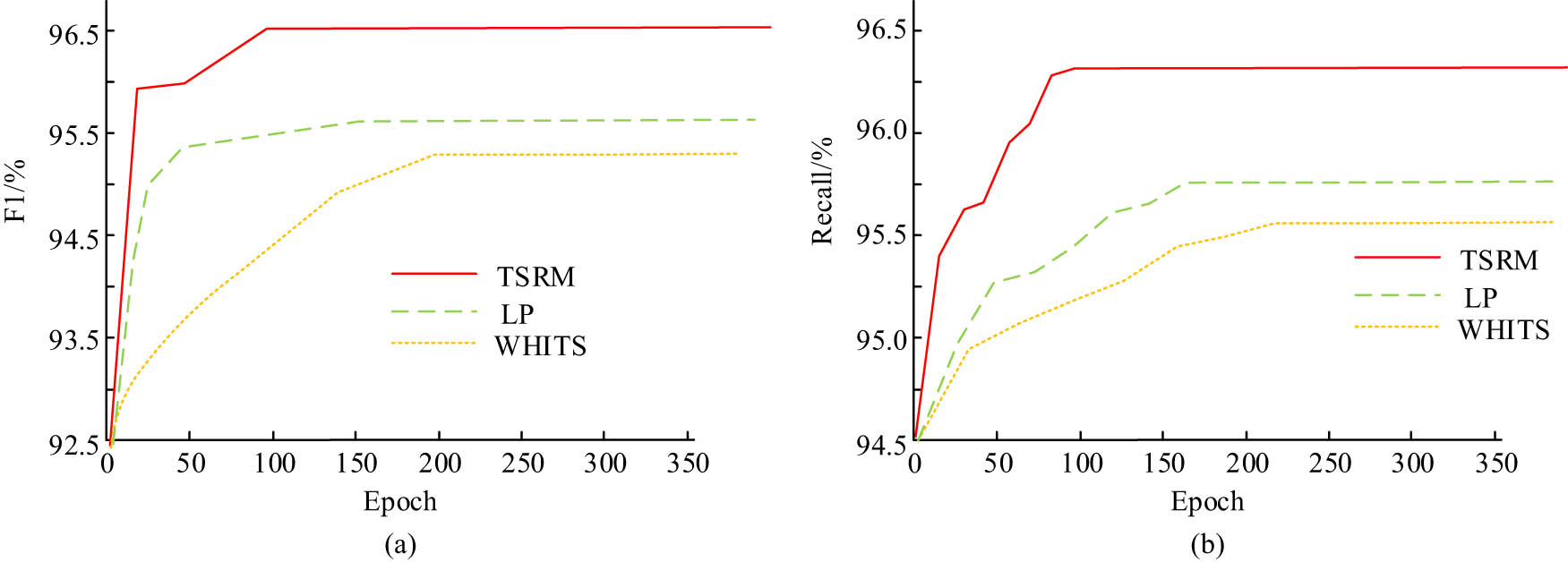
F1 and Recall values of TSRM model, LP model, and WHITS model. (a) F1. (b) Recall.
The recommendation accuracy of the TSRM, the LP, and the WHITS model are compared on the training set and the test set, respectively. Figure 9 is the recommendation accuracy of the three models. The models’ accuracy values increase with the iterations on both the training and test sets. In Figure 9(a), the accuracy variation of the TSRM model, LP model, and WHITS model on the training set is shown. The TSRM accuracy is 98.5%, which is 0.5 and 1.2% higher than the LP and the WHITS. In Figure 9(b), the accuracy variation of the TSRM model, LP model, and WHITS model on the test set is shown. The accuracy of the TSRM is 99.5%. It is 0.4 and 0.9% beyond than those of other two. In summary, the TSRM model has better performance in the work of Q&A teacher recommendation for online learning systems.
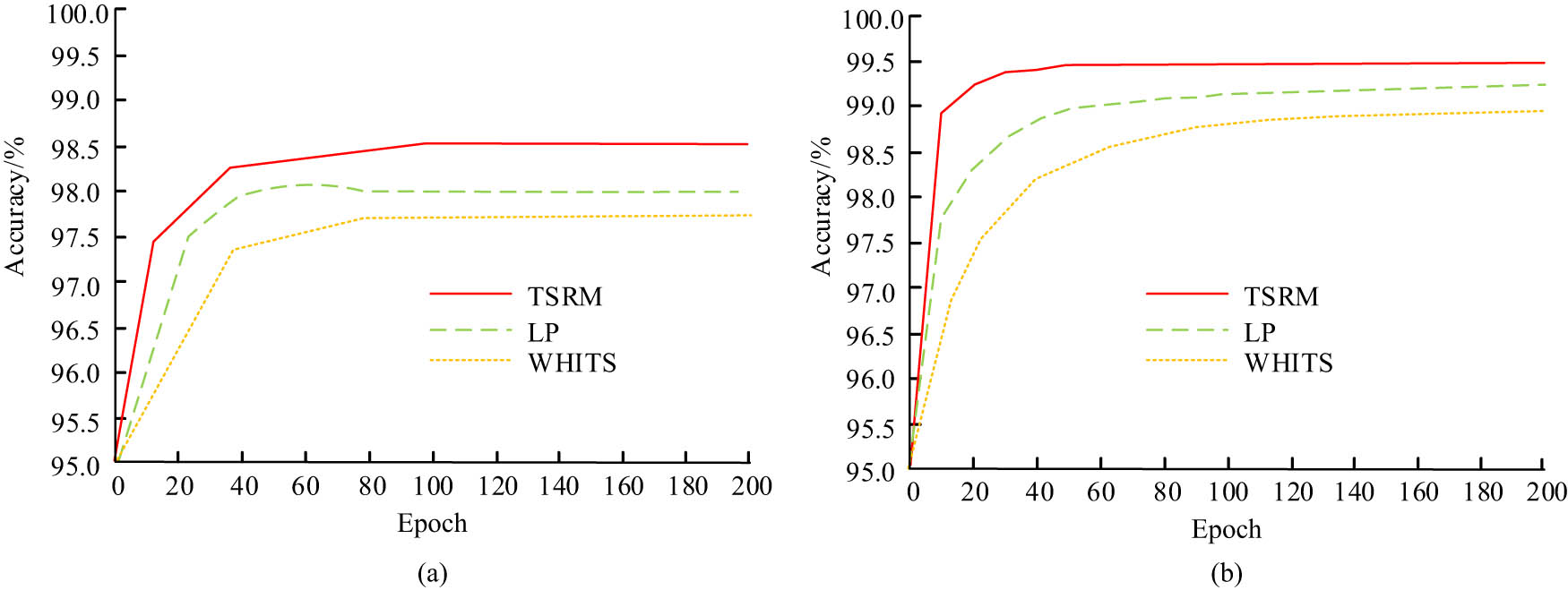
Change in accuracy of models on training and testing sets. (a) Training set. (b) Test set.
4.2 Performance analysis of LSTR model
The LSTR model was tested and compared with the LP model and the WHITS model using the training and test sets described above to demonstrate the LSTR model performance. The variation in MAE values and RMSE values of the LSTR model, LP model, and WHITS model on the training set are exhibited in Figure10. In Figure 10(a), the mean MAE of the LSTR is 3.7%. It is 0.9 and 1.4% lower than LP model and the WHITS, respectively. In Figure 10(b), the mean value of RMSE for the LSTR is 3.3%. It is 0.6 and 1.2% lower than that of the LP and the WHITS, respectively.

Changes in MAE and RMSE values of the model. (a) MAE. (b) RMSE.
In the test set, the recommended success rate and computational complexity test of LSTR model, LP model, and WHITS model are shown in Figure 11. It can be seen that with the increase in the number of model iterations, the recommendation success rate of LSTR model, LP model, and WHITS model is also increasing. As can be seen in Figure 11(a), the LSTR model has a recommendation success rate of 98.4%, which is 4.2 and 4.9% higher than the LP model and WHITS model, respectively. As can be seen from Figure 11(b), the computational complexity of the LSTR model has been optimized very effectively, and it is 63.7 and 86.5% ahead of the LP model and WHITS model, respectively
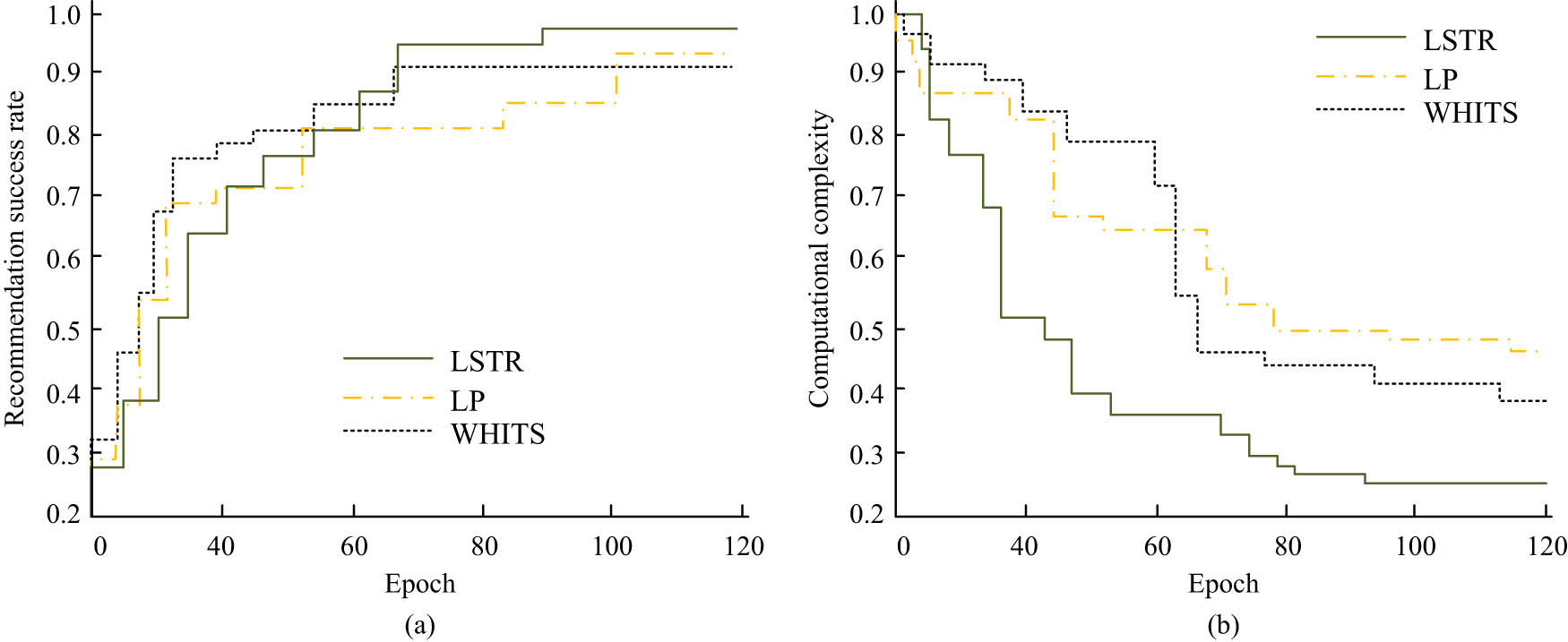
The recommendation success rate of LSTR model, LP model, and WHITS model. (a) Recommendation success rate. (b) Computational complexity.
The comprehensive performance of LSTR model with LP model and WHITS model was evaluated by ROC curve. Figure 12 displays the evaluation results. The AUC value of the LSTR model reaches 0.925, which is 0.014 and 0.020 higher than that of the LP model and the WHITS model.
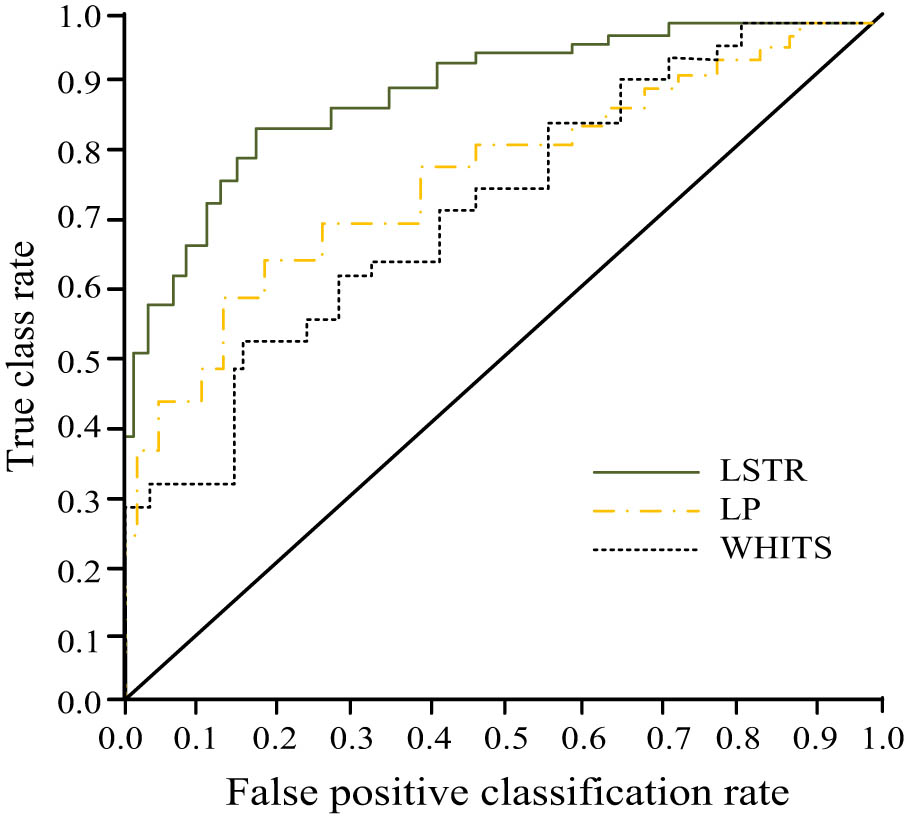
Comprehensive performance evaluation of LSTR model, LP model, and WHITS model.
The mean reciprocal ranking (MRR) and the normalized discounted cumulative gain (NDCG) of the three models were tested, and the test results are shown in Table 2. As can be seen from Table 2, the average reciprocal rank of LSTR model is 0.23, which is higher than LP model and WHITS model by 0.05 and 0.08, respectively. The cumulative normalized loss gain of LSTR model is 0.25, which is 0.08 and 0.09 higher than that of LP model and WHITS model, respectively.
MRR and NDCG test results of three models
| Times | LSTR | LP | WHITS | |||
|---|---|---|---|---|---|---|
| MRR | NDCG | MRR | NDCG | MRR | NDCG | |
| 1 | 0.24 | 0.26 | 0.19 | 0.21 | 0.16 | 0.17 |
| 2 | 0.22 | 0.25 | 0.18 | 0.20 | 0.15 | 0.18 |
| 3 | 0.23 | 0.26 | 0.18 | 0.19 | 0.15 | 0.17 |
| 4 | 0.22 | 0.24 | 0.19 | 0.21 | 0.14 | 0.16 |
| 5 | 0.24 | 0.26 | 0.18 | 0.18 | 0.14 | 0.17 |
| Average | 0.23 | 0.25 | 0.18 | 0.19 | 0.15 | 0.17 |
In summary, the LSTR model and the TSRM model constructed by the study have high performance and can effectively carry out the recommendation of the answering teacher in the online learning system, thus improving the efficiency of solving students’ problem, improving their learning effect, and contributing to the development of education informatization in higher education institutions.
5 Conclusion
In the university online learning system, the intelligent recommendation of answering teachers can effectively improve the problem-solving effect of students and enhance their learning efficiency. Compared with the previous model of the same type, this model has better performance, and also has better comprehensive performance in the actual use test, with stronger practicability and usability. To this end, the LSTR model and TSRM model are constructed and combined to achieve efficient and intelligent Q&A teacher recommendation. The experiment demonstrated that the TSRM requires 99 iterations to reach the optimal state, which is 48 and 103 times less than the LP model and WHITS model, respectively; the error value is 0.02, which is 0.02 and 0.03 lower than the LP and WHITS, respectively; the Loss value is 0.3, which is 0.4 and 0.8 lower than the LP and WHITS, respectively; the F1 value is 96.5% which is 1.1 and 1.4% beyond the LP and WHITS, respectively; Recall value (96.3%) is 0.5 and 1.0% beyond the LP and WHITS, respectively; accuracy of the training set (98.5%) is 0.5 and 1.2% higher than the LP and WHITS, respectively; accuracy of the test set (99.5%) is 0.4% beyond the other two; The mean MAE of LSTR model is 3.7%, which is 0.9 and 1.4% lower than LP model and WHITS model, respectively; the mean RMSE is 3.3%, which is 0.6 and 1.2% lower than LP model and WHITS model, respectively; the recommendation success rate is 98.4%, which is 4.2 and 4.4% higher than LP model and WHITS model, respectively. In summary, the LSTR model and the TSRM model constructed in the study have high performance and can effectively perform the recommendation of answering teachers in online learning systems. The study used the number of likes to assess the quality of teachers’ Q&A, but the index has some limitations, which led to the possible bias of the experimental results. Therefore, the index needs to be improved in the follow-up study so that it can reflect the quality of Q&A more comprehensively and accurately and improve the credibility of the experimental results.
-
Funding information: The authors state no funding involved.
-
Author contributions: Wenyi Lu: Writing – original draft preparation; Ting Wei: Methodology, Zijun Guo & Jianhong Ren: Writing – review and editing.
-
Conflict of interest: The author declares that there is no conflict of interest.
-
Data availability statement: The datasets generated during and/or analyzed during the current study are available from the corresponding author on reasonable request.
References
[1] Castro MDB, Tumibay GM. A literature review: Efficacy of online learning courses for higher education institution using meta-analysis. Educ Inf Technol. 2021;26(2):1367–85.10.1007/s10639-019-10027-zSuche in Google Scholar
[2] Verawardina U, Asnur L, Lubis AL, Hendriyani Y. Reviewing online learning facing the Covid-19 outbreak. J Talent Dev Excell. 2020;12(3s):385–92.Suche in Google Scholar
[3] Simamora RM. The challenges of online learning during the COVID-19 pandemic: An essay analysis of performing arts education students. Stud Learn Teach. 2020;1(2):86–103.10.46627/silet.v1i2.38Suche in Google Scholar
[4] Mohammadi M, Sharifi A. Evaluation of convolutional neural networks for urban map** using satellite images. J Indian Soc Remote Sens. 2021;49(1):2125–31.10.1007/s12524-021-01382-xSuche in Google Scholar
[5] Nejad SMM, Abbasi-Moghadam D, Sharifi A, Farmonov N, Amankulova K, Lászlź M. Multispectral crop yield prediction using 3D-convolutional neural networks and attention convolutional LSTM approaches. IEEE J Sel Top Appl Earth Observ Remote Sens. 2022;16:254–66.10.1109/JSTARS.2022.3223423Suche in Google Scholar
[6] Esmaeili M, Abbasi-Moghadam D, Sharifi A, Tariq A, Li Q. Hyperspectral image band selection based on CNN embedded GA (CNNeGA). IEEE J Sel Top Appl Earth Observ Remote Sens. 2023;16(1):1927–50.10.1109/JSTARS.2023.3242310Suche in Google Scholar
[7] Ali A, Zhu Y, Zakarya M. Exploiting dynamic spatio-temporal graph convolutional neural networks for citywide traffic flows prediction. Neural Netw. 2022;145:233–47.10.1016/j.neunet.2021.10.021Suche in Google Scholar PubMed
[8] Yu X, Lu S, Guo L, Zhang Y. ResGNet-C: A graph convolutional neural network for detection of COVID-19. Neurocomputing. 2021;452:592–605.10.1016/j.neucom.2020.07.144Suche in Google Scholar PubMed PubMed Central
[9] Yu B, Lee Y, Sohn K. Forecasting road traffic speeds by considering area-wide spatio-temporal dependencies based on a graph convolutional neural network (GCN). Transp Res Part C: Emerg Technol. 2020;114:189–204.10.1016/j.trc.2020.02.013Suche in Google Scholar
[10] Chen W, Jiang M, Zhang WG, Chen Z. A novel graph convolutional feature based convolutional neural network for stock trend prediction. Inf Sci. 2021;556:67–94.10.1016/j.ins.2020.12.068Suche in Google Scholar
[11] Louis SY, Zhao Y, Nasiri A, Wang X, Song Y, Liu F, et al. Graph convolutional neural networks with global attention for improved materials property prediction. Phys Chem Chem Phys. 2020;22(32):18141–8.10.1039/D0CP01474ESuche in Google Scholar
[12] Wang J, Chen Q. A traffic prediction model based on multiple factors. J Supercomputing. 2021;77(3):2928–60.10.1007/s11227-020-03373-0Suche in Google Scholar
[13] Mou L, Lu X, Li X, Zhu X. Nonlocal graph convolutional networks for hyperspectral image classification. IEEE Trans Geosci Remote Sens. 2020;58(12):8246–57.10.1109/TGRS.2020.2973363Suche in Google Scholar
[14] Min Y, Wenkel F, Wolf G. Scattering GCN: Overcoming oversmoothness in graph convolutional networks. Adv Neural Inf Process Syst. 2020;33:14498–508.Suche in Google Scholar
[15] Spinelli I, Scardapane S, Uncini A. Missing data imputation with adversarially-trained graph convolutional networks. Neural Netw. 2020;129:249–60.10.1016/j.neunet.2020.06.005Suche in Google Scholar PubMed
[16] Sturluson A, Raza A, McConachie GD, Siderius DW, Fern XZ, Simon CM. Recommendation system to predict missing adsorption properties of nanoporous materials. Chem Mater. 2021;33(18):7203–16.10.1021/acs.chemmater.1c01201Suche in Google Scholar
[17] Zaidan AA, Zaidan BB. A review on intelligent process for smart home applications based on IoT: Coherent taxonomy, motivation, open challenges, and recommendations. Artif Intell Rev. 2020;53(1):141–65.10.1007/s10462-018-9648-9Suche in Google Scholar
[18] Milano S, Taddeo M, Floridi L. Recommender systems and their ethical challenges. Ai Soc. 2020;35:957–67.10.1007/s00146-020-00950-ySuche in Google Scholar
[19] Tahmasebi H, Ravanmehr R, Mohamadrezaei R. Social movie recommender system based on deep autoencoder network using Twitter data. Neural Comput Appl. 2021;33:1607–23.10.1007/s00521-020-05085-1Suche in Google Scholar
[20] Wahab OA, Rjoub G, Bentahar J, Cohen R. Federated against the cold: A trust-based federated learning approach to counter the cold start problem in recommendation systems. Inf Sci. 2022;601:189–206.10.1016/j.ins.2022.04.027Suche in Google Scholar
[21] Paleti L, Radha Krishna P, Murthy JVR. Approaching the cold-start problem using community detection-based alternating least square factorization in recommendation systems. Evolut Intell. 2021;14:835–49.10.1007/s12065-020-00464-ySuche in Google Scholar
[22] Brandão L, Belfo FP, Silva A. Wavelet-based cancer drug recommender system. Procedia Comput Sci. 2021;181:487–94.10.1016/j.procs.2021.01.194Suche in Google Scholar
[23] Chen YX, Wang LC, Chu PC. A recipe parameter recommendation system for an autoclave process and an empirical study. Procedia Manuf. 2020;51:1046–53.10.1016/j.promfg.2020.10.147Suche in Google Scholar
[24] Jelodar H, Wang Y, Zhao G, Rabbain M, Zhao R, Ayobi S, et al. Recommendation system based on semantic scholar mining and topic modeling on conference publications. Soft Comput. 2021;25:3675–96.10.1007/s00500-020-05397-3Suche in Google Scholar
[25] Lyu D, Chen L, Xu Z, Yu S. Weighted multi-information constrained matrix factorization for personalized travel location recommendation based on geo-tagged photos. Appl Intell. 2020;50(1):924–38.10.1007/s10489-019-01566-6Suche in Google Scholar
[26] Caro-Martínez M, Jiménez-Díaz G, Recio-García JA. Conceptual modeling of explainable recommender systems: an ontological formalization to guide their design and development. J Artif Intell Res. 2021;71:557–89.10.1613/jair.1.12789Suche in Google Scholar
[27] Guan H, Shizhong HE, Qiuqiu LI, Yang Z, Qin C, Weichu HE. A review of convolutional neural networks in equipment wear particle recognition. Tribology. 2022;42(2):426–45.Suche in Google Scholar
[28] Liu J, Wang Z, Xu M. DeepMTT: A deep learning maneuvering target-tracking algorithm based on bidirectional LSTM network. Inf Fusion. 2020;53(1):289–304.10.1016/j.inffus.2019.06.012Suche in Google Scholar
[29] Chalyi S, Leshchynskyi V. Method of constructing explanations for recommender systems based on the temporal dynamics of user preferences. EUREKA Phys Eng. 2020;3(3):43–50.10.21303/2461-4262.2020.001228Suche in Google Scholar
[30] Li M, Li W, Wang F, Jia X, Rui G. Applying BERT to analyze investor sentiment in stock market. Neural Comput Appl. 2021;33(10):4663–76.10.1007/s00521-020-05411-7Suche in Google Scholar
[31] Kou J, Zhan T, Zhou D, Xie Y, Da Z, Gong M. Visual attention-based siamese CNN with SoftmaxFocal loss for laser-induced damage change detection of optical elements. Neurocomputing. 2023;517(14):173–87.10.1016/j.neucom.2022.10.074Suche in Google Scholar
© 2024 the author(s), published by De Gruyter
This work is licensed under the Creative Commons Attribution 4.0 International License.
Artikel in diesem Heft
- Research Articles
- A study on intelligent translation of English sentences by a semantic feature extractor
- Detecting surface defects of heritage buildings based on deep learning
- Combining bag of visual words-based features with CNN in image classification
- Online addiction analysis and identification of students by applying gd-LSTM algorithm to educational behaviour data
- Improving multilayer perceptron neural network using two enhanced moth-flame optimizers to forecast iron ore prices
- Sentiment analysis model for cryptocurrency tweets using different deep learning techniques
- Periodic analysis of scenic spot passenger flow based on combination neural network prediction model
- Analysis of short-term wind speed variation, trends and prediction: A case study of Tamil Nadu, India
- Cloud computing-based framework for heart disease classification using quantum machine learning approach
- Research on teaching quality evaluation of higher vocational architecture majors based on enterprise platform with spherical fuzzy MAGDM
- Detection of sickle cell disease using deep neural networks and explainable artificial intelligence
- Interval-valued T-spherical fuzzy extended power aggregation operators and their application in multi-criteria decision-making
- Characterization of neighborhood operators based on neighborhood relationships
- Real-time pose estimation and motion tracking for motion performance using deep learning models
- QoS prediction using EMD-BiLSTM for II-IoT-secure communication systems
- A novel framework for single-valued neutrosophic MADM and applications to English-blended teaching quality evaluation
- An intelligent error correction model for English grammar with hybrid attention mechanism and RNN algorithm
- Prediction mechanism of depression tendency among college students under computer intelligent systems
- Research on grammatical error correction algorithm in English translation via deep learning
- Microblog sentiment analysis method using BTCBMA model in Spark big data environment
- Application and research of English composition tangent model based on unsupervised semantic space
- 1D-CNN: Classification of normal delivery and cesarean section types using cardiotocography time-series signals
- Real-time segmentation of short videos under VR technology in dynamic scenes
- Application of emotion recognition technology in psychological counseling for college students
- Classical music recommendation algorithm on art market audience expansion under deep learning
- A robust segmentation method combined with classification algorithms for field-based diagnosis of maize plant phytosanitary state
- Integration effect of artificial intelligence and traditional animation creation technology
- Artificial intelligence-driven education evaluation and scoring: Comparative exploration of machine learning algorithms
- Intelligent multiple-attributes decision support for classroom teaching quality evaluation in dance aesthetic education based on the GRA and information entropy
- A study on the application of multidimensional feature fusion attention mechanism based on sight detection and emotion recognition in online teaching
- Blockchain-enabled intelligent toll management system
- A multi-weapon detection using ensembled learning
- Deep and hand-crafted features based on Weierstrass elliptic function for MRI brain tumor classification
- Design of geometric flower pattern for clothing based on deep learning and interactive genetic algorithm
- Mathematical media art protection and paper-cut animation design under blockchain technology
- Deep reinforcement learning enhances artistic creativity: The case study of program art students integrating computer deep learning
- Transition from machine intelligence to knowledge intelligence: A multi-agent simulation approach to technology transfer
- Research on the TF–IDF algorithm combined with semantics for automatic extraction of keywords from network news texts
- Enhanced Jaya optimization for improving multilayer perceptron neural network in urban air quality prediction
- Design of visual symbol-aided system based on wireless network sensor and embedded system
- Construction of a mental health risk model for college students with long and short-term memory networks and early warning indicators
- Personalized resource recommendation method of student online learning platform based on LSTM and collaborative filtering
- Employment management system for universities based on improved decision tree
- English grammar intelligent error correction technology based on the n-gram language model
- Speech recognition and intelligent translation under multimodal human–computer interaction system
- Enhancing data security using Laplacian of Gaussian and Chacha20 encryption algorithm
- Construction of GCNN-based intelligent recommendation model for answering teachers in online learning system
- Neural network big data fusion in remote sensing image processing technology
- Research on the construction and reform path of online and offline mixed English teaching model in the internet era
- Real-time semantic segmentation based on BiSeNetV2 for wild road
- Online English writing teaching method that enhances teacher–student interaction
- Construction of a painting image classification model based on AI stroke feature extraction
- Big data analysis technology in regional economic market planning and enterprise market value prediction
- Location strategy for logistics distribution centers utilizing improved whale optimization algorithm
- Research on agricultural environmental monitoring Internet of Things based on edge computing and deep learning
- The application of curriculum recommendation algorithm in the driving mechanism of industry–teaching integration in colleges and universities under the background of education reform
- Application of online teaching-based classroom behavior capture and analysis system in student management
- Evaluation of online teaching quality in colleges and universities based on digital monitoring technology
- Face detection method based on improved YOLO-v4 network and attention mechanism
- Study on the current situation and influencing factors of corn import trade in China – based on the trade gravity model
- Research on business English grammar detection system based on LSTM model
- Multi-source auxiliary information tourist attraction and route recommendation algorithm based on graph attention network
- Multi-attribute perceptual fuzzy information decision-making technology in investment risk assessment of green finance Projects
- Research on image compression technology based on improved SPIHT compression algorithm for power grid data
- Optimal design of linear and nonlinear PID controllers for speed control of an electric vehicle
- Traditional landscape painting and art image restoration methods based on structural information guidance
- Traceability and analysis method for measurement laboratory testing data based on intelligent Internet of Things and deep belief network
- A speech-based convolutional neural network for human body posture classification
- The role of the O2O blended teaching model in improving the teaching effectiveness of physical education classes
- Genetic algorithm-assisted fuzzy clustering framework to solve resource-constrained project problems
- Behavior recognition algorithm based on a dual-stream residual convolutional neural network
- Ensemble learning and deep learning-based defect detection in power generation plants
- Optimal design of neural network-based fuzzy predictive control model for recommending educational resources in the context of information technology
- An artificial intelligence-enabled consumables tracking system for medical laboratories
- Utilization of deep learning in ideological and political education
- Detection of abnormal tourist behavior in scenic spots based on optimized Gaussian model for background modeling
- RGB-to-hyperspectral conversion for accessible melanoma detection: A CNN-based approach
- Optimization of the road bump and pothole detection technology using convolutional neural network
- Comparative analysis of impact of classification algorithms on security and performance bug reports
- Cross-dataset micro-expression identification based on facial ROIs contribution quantification
- Demystifying multiple sclerosis diagnosis using interpretable and understandable artificial intelligence
- Unifying optimization forces: Harnessing the fine-structure constant in an electromagnetic-gravity optimization framework
- E-commerce big data processing based on an improved RBF model
- Analysis of youth sports physical health data based on cloud computing and gait awareness
- CCLCap-AE-AVSS: Cycle consistency loss based capsule autoencoders for audio–visual speech synthesis
- An efficient node selection algorithm in the context of IoT-based vehicular ad hoc network for emergency service
- Computer aided diagnoses for detecting the severity of Keratoconus
- Improved rapidly exploring random tree using salp swarm algorithm
- Network security framework for Internet of medical things applications: A survey
- Predicting DoS and DDoS attacks in network security scenarios using a hybrid deep learning model
- Enhancing 5G communication in business networks with an innovative secured narrowband IoT framework
- Quokka swarm optimization: A new nature-inspired metaheuristic optimization algorithm
- Digital forensics architecture for real-time automated evidence collection and centralization: Leveraging security lake and modern data architecture
- Image modeling algorithm for environment design based on augmented and virtual reality technologies
- Enhancing IoT device security: CNN-SVM hybrid approach for real-time detection of DoS and DDoS attacks
- High-resolution image processing and entity recognition algorithm based on artificial intelligence
- Review Articles
- Transformative insights: Image-based breast cancer detection and severity assessment through advanced AI techniques
- Network and cybersecurity applications of defense in adversarial attacks: A state-of-the-art using machine learning and deep learning methods
- Applications of integrating artificial intelligence and big data: A comprehensive analysis
- A systematic review of symbiotic organisms search algorithm for data clustering and predictive analysis
- Modelling Bitcoin networks in terms of anonymity and privacy in the metaverse application within Industry 5.0: Comprehensive taxonomy, unsolved issues and suggested solution
- Systematic literature review on intrusion detection systems: Research trends, algorithms, methods, datasets, and limitations
Artikel in diesem Heft
- Research Articles
- A study on intelligent translation of English sentences by a semantic feature extractor
- Detecting surface defects of heritage buildings based on deep learning
- Combining bag of visual words-based features with CNN in image classification
- Online addiction analysis and identification of students by applying gd-LSTM algorithm to educational behaviour data
- Improving multilayer perceptron neural network using two enhanced moth-flame optimizers to forecast iron ore prices
- Sentiment analysis model for cryptocurrency tweets using different deep learning techniques
- Periodic analysis of scenic spot passenger flow based on combination neural network prediction model
- Analysis of short-term wind speed variation, trends and prediction: A case study of Tamil Nadu, India
- Cloud computing-based framework for heart disease classification using quantum machine learning approach
- Research on teaching quality evaluation of higher vocational architecture majors based on enterprise platform with spherical fuzzy MAGDM
- Detection of sickle cell disease using deep neural networks and explainable artificial intelligence
- Interval-valued T-spherical fuzzy extended power aggregation operators and their application in multi-criteria decision-making
- Characterization of neighborhood operators based on neighborhood relationships
- Real-time pose estimation and motion tracking for motion performance using deep learning models
- QoS prediction using EMD-BiLSTM for II-IoT-secure communication systems
- A novel framework for single-valued neutrosophic MADM and applications to English-blended teaching quality evaluation
- An intelligent error correction model for English grammar with hybrid attention mechanism and RNN algorithm
- Prediction mechanism of depression tendency among college students under computer intelligent systems
- Research on grammatical error correction algorithm in English translation via deep learning
- Microblog sentiment analysis method using BTCBMA model in Spark big data environment
- Application and research of English composition tangent model based on unsupervised semantic space
- 1D-CNN: Classification of normal delivery and cesarean section types using cardiotocography time-series signals
- Real-time segmentation of short videos under VR technology in dynamic scenes
- Application of emotion recognition technology in psychological counseling for college students
- Classical music recommendation algorithm on art market audience expansion under deep learning
- A robust segmentation method combined with classification algorithms for field-based diagnosis of maize plant phytosanitary state
- Integration effect of artificial intelligence and traditional animation creation technology
- Artificial intelligence-driven education evaluation and scoring: Comparative exploration of machine learning algorithms
- Intelligent multiple-attributes decision support for classroom teaching quality evaluation in dance aesthetic education based on the GRA and information entropy
- A study on the application of multidimensional feature fusion attention mechanism based on sight detection and emotion recognition in online teaching
- Blockchain-enabled intelligent toll management system
- A multi-weapon detection using ensembled learning
- Deep and hand-crafted features based on Weierstrass elliptic function for MRI brain tumor classification
- Design of geometric flower pattern for clothing based on deep learning and interactive genetic algorithm
- Mathematical media art protection and paper-cut animation design under blockchain technology
- Deep reinforcement learning enhances artistic creativity: The case study of program art students integrating computer deep learning
- Transition from machine intelligence to knowledge intelligence: A multi-agent simulation approach to technology transfer
- Research on the TF–IDF algorithm combined with semantics for automatic extraction of keywords from network news texts
- Enhanced Jaya optimization for improving multilayer perceptron neural network in urban air quality prediction
- Design of visual symbol-aided system based on wireless network sensor and embedded system
- Construction of a mental health risk model for college students with long and short-term memory networks and early warning indicators
- Personalized resource recommendation method of student online learning platform based on LSTM and collaborative filtering
- Employment management system for universities based on improved decision tree
- English grammar intelligent error correction technology based on the n-gram language model
- Speech recognition and intelligent translation under multimodal human–computer interaction system
- Enhancing data security using Laplacian of Gaussian and Chacha20 encryption algorithm
- Construction of GCNN-based intelligent recommendation model for answering teachers in online learning system
- Neural network big data fusion in remote sensing image processing technology
- Research on the construction and reform path of online and offline mixed English teaching model in the internet era
- Real-time semantic segmentation based on BiSeNetV2 for wild road
- Online English writing teaching method that enhances teacher–student interaction
- Construction of a painting image classification model based on AI stroke feature extraction
- Big data analysis technology in regional economic market planning and enterprise market value prediction
- Location strategy for logistics distribution centers utilizing improved whale optimization algorithm
- Research on agricultural environmental monitoring Internet of Things based on edge computing and deep learning
- The application of curriculum recommendation algorithm in the driving mechanism of industry–teaching integration in colleges and universities under the background of education reform
- Application of online teaching-based classroom behavior capture and analysis system in student management
- Evaluation of online teaching quality in colleges and universities based on digital monitoring technology
- Face detection method based on improved YOLO-v4 network and attention mechanism
- Study on the current situation and influencing factors of corn import trade in China – based on the trade gravity model
- Research on business English grammar detection system based on LSTM model
- Multi-source auxiliary information tourist attraction and route recommendation algorithm based on graph attention network
- Multi-attribute perceptual fuzzy information decision-making technology in investment risk assessment of green finance Projects
- Research on image compression technology based on improved SPIHT compression algorithm for power grid data
- Optimal design of linear and nonlinear PID controllers for speed control of an electric vehicle
- Traditional landscape painting and art image restoration methods based on structural information guidance
- Traceability and analysis method for measurement laboratory testing data based on intelligent Internet of Things and deep belief network
- A speech-based convolutional neural network for human body posture classification
- The role of the O2O blended teaching model in improving the teaching effectiveness of physical education classes
- Genetic algorithm-assisted fuzzy clustering framework to solve resource-constrained project problems
- Behavior recognition algorithm based on a dual-stream residual convolutional neural network
- Ensemble learning and deep learning-based defect detection in power generation plants
- Optimal design of neural network-based fuzzy predictive control model for recommending educational resources in the context of information technology
- An artificial intelligence-enabled consumables tracking system for medical laboratories
- Utilization of deep learning in ideological and political education
- Detection of abnormal tourist behavior in scenic spots based on optimized Gaussian model for background modeling
- RGB-to-hyperspectral conversion for accessible melanoma detection: A CNN-based approach
- Optimization of the road bump and pothole detection technology using convolutional neural network
- Comparative analysis of impact of classification algorithms on security and performance bug reports
- Cross-dataset micro-expression identification based on facial ROIs contribution quantification
- Demystifying multiple sclerosis diagnosis using interpretable and understandable artificial intelligence
- Unifying optimization forces: Harnessing the fine-structure constant in an electromagnetic-gravity optimization framework
- E-commerce big data processing based on an improved RBF model
- Analysis of youth sports physical health data based on cloud computing and gait awareness
- CCLCap-AE-AVSS: Cycle consistency loss based capsule autoencoders for audio–visual speech synthesis
- An efficient node selection algorithm in the context of IoT-based vehicular ad hoc network for emergency service
- Computer aided diagnoses for detecting the severity of Keratoconus
- Improved rapidly exploring random tree using salp swarm algorithm
- Network security framework for Internet of medical things applications: A survey
- Predicting DoS and DDoS attacks in network security scenarios using a hybrid deep learning model
- Enhancing 5G communication in business networks with an innovative secured narrowband IoT framework
- Quokka swarm optimization: A new nature-inspired metaheuristic optimization algorithm
- Digital forensics architecture for real-time automated evidence collection and centralization: Leveraging security lake and modern data architecture
- Image modeling algorithm for environment design based on augmented and virtual reality technologies
- Enhancing IoT device security: CNN-SVM hybrid approach for real-time detection of DoS and DDoS attacks
- High-resolution image processing and entity recognition algorithm based on artificial intelligence
- Review Articles
- Transformative insights: Image-based breast cancer detection and severity assessment through advanced AI techniques
- Network and cybersecurity applications of defense in adversarial attacks: A state-of-the-art using machine learning and deep learning methods
- Applications of integrating artificial intelligence and big data: A comprehensive analysis
- A systematic review of symbiotic organisms search algorithm for data clustering and predictive analysis
- Modelling Bitcoin networks in terms of anonymity and privacy in the metaverse application within Industry 5.0: Comprehensive taxonomy, unsolved issues and suggested solution
- Systematic literature review on intrusion detection systems: Research trends, algorithms, methods, datasets, and limitations

